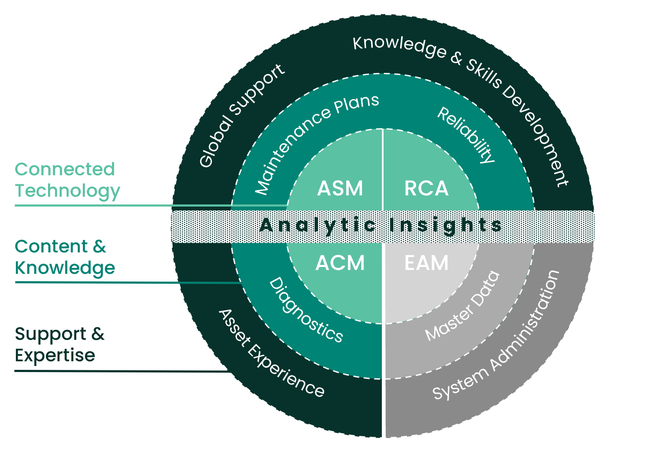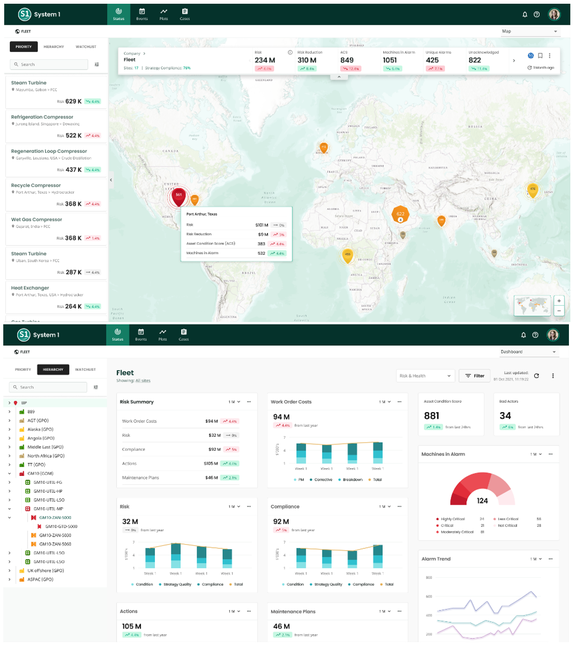
Integrated Asset Performance Management …an introduction to pathology and treatment!
To understand ‘why?’ one should consider an integrated approach to Asset Performance Management (APM), and what is it exactly, one must first appreciate the problem it aims to solve – so let’s start there, in a series of articles that should culminate with a comprehensive understanding of the overall subject.
As more man-made machines are built and deployed around the world, specifically in industrial applications, they get bigger, often more complex and push the boundaries of design and operation. The need for their real-time monitoring became evident in the 60s and was adopted prevalently for critical machines from the 80s. As computer-based software matured through the 90s, capability came in to place to effectively historize machine health data and visualize their behavioral patterns for an expert to conduct causal analysis whether done proactively or after unplanned events occurred.
In parallel, Reliability and Maintenance practices matured through experience, and with each new project deployment came improvements in baseline strategies. Eventually, edge sensing and demand for operations data availability became a norm for on-premise (edge) at industrial manufacturing and processing facilities to support those maturing strategies and enable better informed decision making throughout an asset’s life cycle.
But, all this occurred in domain silos as expertise was field specific, solutions were provided by different vendors, and each functional discipline aimed to improve only their role at the expense of an integrated asset performance management approach.
Fast forward to the most recent decade, operational enterprises have become geographically diverse and reached scales previously unimaginable. The good news is that heavy industries are not alone in this phenomenon and need for data driven transformation; the consumer world is almost a decade ahead, hence directionally correct solutions existed already designed for aggregation, historization, visualization, and processing of Big Data across previously stand-alone systems.
In asset-intensive industries like oil and gas, mining, utilities, and manufacturing, business outcomes are now intrinsically linked to asset performance, and in turn data dependent. This is particularly true when every organization has access to the same assets and competitive advantage comes from extracting the best possible performance. The challenge then, is to extract high performance from assets with financially optimized maintenance and monitoring, while operating them within the desired risk profile – that would happen through data informed decisions and effective application of expertise.
An industrial manufacturing and process facility, however, is a complex system of systems and to understand it wholistically, all available system datasets must work together to rationalize cause and effect relationships for effective and timely decisions by business leaders.
Over the past five years or so, many industrial operators have tried their hand at transformational projects that digitized their assets data flow and provided an aggregate central pool from a technology point of view. Many studies are finding, however, that a large share of digital transformation projects fail to deliver their targeted asset performance improvement outcomes.
One of these studies - a McKinsey Global Survey on digital transformations (Boutetiere et al., 2018) - reported that more than eight in ten respondents said their organization had indeed undertaken a transformation initiative in the five years prior. However, only 16% of respondents said their organizations’ digital transformation successfully improved performance and equipped them to sustain changes in the long term. Essentially, what has held them back – is a continuation of edge silo’s whilst simply aiming for data aggregation at the enterprise layer using technology that otherwise did not drive an integrated work process and lacked consideration for the ability to augment the solution with human expertise. In other words, a separate list of functional capabilities was compiled for Asset Condition Monitoring (ACM), Asset Strategy Management (ASM), and Defect Elimination and then executed as a project
A problem arises when little thought is given to how these different functional areas work with each other and interoperate with the user’s work execution management system, often resulting in poor adoption of the APM solution. Successful digital transformation requires more than just an IT-based technical connection of an APM solution to a work management solution. It requires an integration that supports a productive, sustainable and practical connection of the asset performance improvement process and the work management process, so they are harmonized.
Rapid evolution of the enterprise asset management technology landscape and exponential growth of data now being managed has compounded existing challenges faced by large organizations around siloed functions and applications.
Interestingly as of recent, an over positioning of Artificial Intelligence (AI) with/without Machine Learning (ML) capability as a platform over an aggregated data lake, has only exacerbated the silo problem. Don’t get me wrong, tools that enable Autonomous Intelligence based actions are certainly powerful and absolutely needed to augment human expertise to achieve success at scale, yet they are not mutually exclusive i.e. AI does not replace human expertise, it only extends its scale and alleviates the expert from menial tasks (searching for anomalies or previously known failure modes) to allow for informed decision-making focus.
In the vast majority of cases, data from the key APM functions of asset strategy, asset health and condition monitoring, and work management are captured in different data systems or different data models and cannot easily be integrated into a holistic and consolidated view. Defect elimination practices and tools are also operated in a stand-alone fashion by plant reliability engineers. Organizations are finding that simply compiling different data sources into a central data destination does not support more valuable insights due to a lack of consistency in the structure of the disparate data sources, and the ability to correlate between them, which prevents organizations from forming meaningful connections and insights necessary to drive improved outcomes.
The definition of Asset Performance Management itself is quite broad and encompasses a number of different tools and processes to help organizations get the most out of their assets and improve reliability. To reiterate, the four most critical aspects of APM include Asset Condition Monitoring, Asset Strategy Management, Defect Elimination, and Work Execution Management supported by an Enterprise Asset Management (EAM) application.
Asset Condition Monitoring is the practice of using software and hardware to monitor machinery condition. It can be effective at managing the risk of catastrophic failure, particularly on critical machines, by providing alerts when intervention is required or executing an automated safety shutdown when preset thresholds are crossed. It is also highly valuable as a maintenance planning tool for essential machines.
The use of ACM has expanded in recent years due to advancements in technology and a subsequent reduction in cost to implement at scale. However, systematic monitoring of asset health has been fundamentally tactical/reactive, falling short of the capabilities to deliver asset optimization and improvement. As a standalone activity, ACM will continue to be limited in its success without seamless reliability strategy/maintenance plan and work management association, driving corrective actions to be automatically actioned and its value yield visible as asset health improvement.
Asset Strategy Management is a best practice approach to managing asset maintenance strategies across the full lifecycle of an asset, organization-wide. It is a process enabled by people, technology and data, to connect physical assets and independent plants and sites to a central system, allowing asset strategies to be effectively implemented, maintained and optimized. These strategies include optimized maintenance plans that deliver performance improvements and lower costs through increased reliability and the reduction of failures, downtime and risk.
An ASM program also generates maintenance plan master data for loading to the CMMS/EAM. Data includes the tasks to be performed, when they are to be performed, how they are to be performed, who does them and what materials, work instructions and safety considerations are required. Similar to ACM, when ASM activities are performed in a silo, the outcomes are limited to typically baseline setup for projects and one-time load of maintenance plans to the CMMS and thereafter either kept static (hence, out of date eventually) or manually updated on a machine case basis due to event based Root Cause Analysis (RCA), leading to inconsistencies and challenges with scalability of success and resulting in the performance of maintenance tasks that are not aligned to the current health and condition of the asset.
The identification of defects through obvious breakdowns, undesirable availability and/or reoccurring problems can be achieved through Reliability Availability Maintainability (RAM) studies and/or Process Reliability studies. These studies will prioritize the detection and mitigation of defects that have the biggest impact on operational availability, asset life or safety.
Root Cause Analysis is the foundation of a Defect Elimination process. RCA should identify causes using input from all stakeholders to produce an evidence-based understanding of the problem. This evidence-based approach ensures selected solutions prevent recurrence. Still, they come with their limitations when done only post loss events, often being limited to top ten visible risks and almost always disconnected from reliability strategy and condition monitoring programs. Given their event-based nature, focus dissipates rapidly after initial resolution on the specific asset in focus, leaving challenges with benchmarking and scalability across like assets.
Work execution is focused on execution of asset strategies and maintenance tasks, including both routine maintenance and time-sensitive maintenance or repair actions resulting from deteriorating machine condition. Work execution is typically supported by software that helps schedule work more efficiently while tracking costs and work history.
Given how embedded the work management process is in many organizations, there is a tendency to focus on maintenance execution alone. It is a misconception that an EAM software contains the right work tasks and intervals and ’blind’ consistent implementation of these strategies will result in improvements to asset reliability. However, the execution of inconsistent or sub-optimal strategies can hamper performance and lead to inconsistent results, continued under-performance, and significant asset failures and forced outages.
Conducting work execution management in a silo allows maintenance plan master data to be changed with little oversight, resulting in different sites having inconsistent maintenance plans for similar assets with similar conditions. Further, it is difficult to correlate business performance with the underlying asset strategies and activities. Only through a living integrated approach to APM is it possible to improve plans, reduce costs and understand risk in a predictable manner.
Integrated APM digitally connects these traditionally siloed functions, creating a unified approach that enables organizations to demonstrate compliance, reduce risk, manage costs and deliver predictable performance. Unlike traditional approaches to APM, Integrated APM provides a comprehensive view of asset health and risk, accounting for asset age, operating condition, maintenance plans and strategy compliance. The insights gained provide a sound foundation for data-driven performance management, helping organizations prioritize activities to manage cost and risk over changing operating conditions, age and health of an asset.
An integrated approach to APM also supports continuous improvement of asset care and reliability. For example, any operating context or asset change can be reflected in asset strategies and monitoring applications in real-time. Evergreen connection to the EAM application and work management process drives changes through to work execution in the field and completes the feedback loop to validate work effectiveness.
To address scalability of information processing and work prioritization rationale, Analytic Insights provide users with a suite of capability. For an integrated approach to APM to be sustainable and scalable across an entire enterprise, fit-for-purpose autonomous intelligence tools are needed. These can range from predictive alerts for asset health leveraging advanced analytic techniques bolstered by physics-based failure mode categorization and purpose built AI solutions, to open workbench citizen developer platforms that allow end user Subject Matter Experts (SMEs) to codify their knowhow. The results are a dynamic, agile, scalable and comprehensive approach to equipment maintenance and reliability, in sync with operational goals.
To conclude, understanding of the asset performance management problem pathology and treatment via an integrated APM approach, there is one key aspect to highlight that was eluded towards earlier: the human factor. As highlighted earlier referencing the study from McKinsey, the vast majority of enterprise-wide digital transformation programs failed due failure to address the human aspects of culture, work process integration and augmentation of human domain expertise. A successful implementation of Integrated APM must involve the solution provider’s domain experts as well as the operators. It must incorporate a thoughtful knowledge transfer program and technical support structure that enables the user to ‘take it and run with it’.
While the pillars of an Integrated APM ecosystem provide key functionality as stand-alone solutions described, they provide the most value when brought together to deliver full visibility to asset health and performance optimization. Consider the challenges of managing risk in an environment where data is siloed across different applications. An organization using ACM may have lots of different alarms going off which suggest risk resulting from a degradation in asset condition. The same organization may have risk exposures resulting from suboptimal or poorly executed asset care plans. If these risks remain compartmentalized, it is impossible to understand the ‘real’ risk associated with the asset. By integrating these functions and their associated workflows into a ‘master workflow,’ these risks become rationalized and are easier to understand and fully address.
Bently Nevada delivers this connected ecosystem through our System 1 Integrated APM software platform, underpinned by our 60+ years of domain expertise which enables customers to maximize productivity through intelligent risk-based reliability management. Our contemporary enterprise-level, web-based interface provides easy-to-understand summary KPIs and enhanced asset health drill-down views to support the information needs of business leaders and asset management professionals alike.
System 1 Integrated APM provides users with a single pane of glass view, unifying insights from ASM and ACM capabilities, further powered by fit-for-purpose Analytic Insights to drive efficient work prioritization, case management and work execution across their enterprise. Our solution provides operators with a robust connection gateway with standard C2C, E2C and E2E interfacing, enabling seamless interoperability from the edge to enterprise.
In future articles on this topic series, we will build upon the baseline understanding of the challenges an Integrated APM solution addresses by exploring the specific capabilities of each capability pillar and program implementation best practices to further highlight the people, process and technology necessary to achieve a successful Digital Transformation journey.
Boutetiere, H. and Montagner, A. and Reich, A. (2018 October 29) "Unlocking success in digital transformations." McKinsey & Company. [accessed 2021 November 15] https://www.mckinsey.com/business-functions/people-and-organizational-p…
Our Experts

Munir Qureshi
Global Leader- Application & Solution Architect



